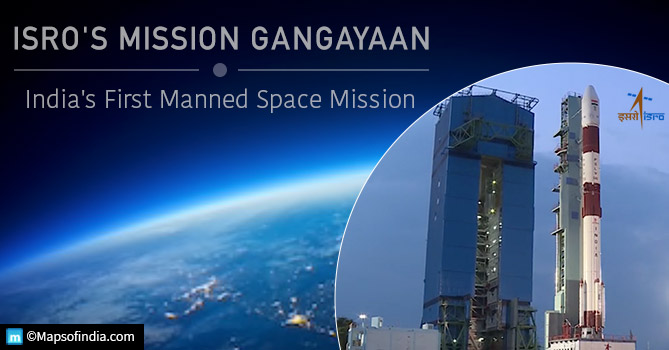While addressing the people of India on the event of Independence Day from the ramparts of Red Fort, Prime Minister Narendra Modi made an announcement that three Indian men or women would go into space by 2022. This has put Indian Space Research Organisation (ISRO) under great pressure as with this announcement, it has finally got a conclusive deadline for the Gangayaan project it has been working on since 2004.
With the Gangayaan mission in action, Indian Space Research Organisation (ISRO) will send an Indian astronaut into space for a period of seven days as part of this mission by 2022. This manned mission of India will have three crew members that will enter the Low Earth orbit for five to seven days with the indigenous Mark GSLV III launch vehicle. The estimated cost of this mission is somewhere around Rs. 10,000 crores.
This manned space mission of ISRO is unique from all other missions that it has conducted so far. If we go by the intricacy and goal, the missions to the Moon (Chandrayaan) and Mars (Mangalyaan) stand nowhere in comparison to this mission. After the success of this mission, India will become the fourth country to send a human into space, after the USSR, USA, and China.
What is the objective behind this manned mission?
The main objective of this mission is to create a spaceship, called Gangayaan, that will carry three humans to the low earth orbit and then return back to the planet after a duration of about seven days.
This mission requires some primary distinctive features to be developed by ISRO like the proficiency to bring the spacecraft back to the earth after the completion of the mission, and to build the spacecraft with such expertise that astronauts can have the same atmosphere as on the earth even in space. Over the years, the space agency has been successful in developing some of these technologies, but many others are still to be developed and tested.
The Launch Vehicle: GSLV Mk-III
For the Gangayaan Mission, the creation of a launch vehicle that will take the heavy payloads to the low earth orbit was the most crucial. The GSLV Mk-III, now called LVM-3 (Launch Vehicle Mark-3), a launch vehicle has been developed by ISRO for the mission. The space agency successfully tested this launch vehicle in an experimental flight on December 18, 2014. It will carry the astronauts in a crew module into space and then back to the earth.
Crew Escape System
ISRO has taken great precaution while working on the crew escape system. This vital safety technology involves an emergency escape mechanism for the crew members in case of a faulty launch. The mechanism will make sure that the crew module gets a prior warning of any fault with the spacecraft.
Life support system
The Environmental Control & Life Support System (ECLSS) will make sure that the conditions inside the crew module are convenient for the humans to live. The system will maintain a stable cabin pressure and air balance, eliminates carbon dioxide and other harmful gases, controls temperature and humidity, and other things.
Astronaut training
Initially, there were plans of setting up an astronaut training center in Bangalore but nothing shaped up. ISRO is still working on the plans to set up a full-fledged training facility where the people selected for this mission could be trained. Some training would also be provided at the Indian Air Force’s Institute of Aerospace Medicine situated at Bengaluru. The process of shortlisting the candidates has not yet begun.
Under the training, the selected candidates would be trained for a period of minimum two years. They will be trained to get used to living in the zero gravity and dealing with a myriad of unexpected situations of living in space.
Other missions of ISRO
- Mission Gangayaan: A Manned Space Mission Of ISRO
- Swadeshi Space Shuttle
- ISRO: Touching space and beyond
- ISRO to launch India’s first private-built satellite
- ISRO Tastes Success Again With the Launch of Cartosat-2 Satellite
- ISRO Successfully Launches The GSLV-Mk III On Monday
- ISRO launches South Asia Satellite GSAT-9 from Sriharikota
- ISRO Creates History; Launches 104 Satellites At a Go
- ISRO Planning 68 Satellites’ Launch in One Mission
- ISRO’s 20-Satellite Launch: Why It’s Special
- ISRO to launch GSAT-6 communication satellite on 27 August
- Secret behind ISRO’s next Interplanetary Mission
- The ISRO/Antrix – Devas Deal
- Mars Orbiter Mission (MOM) – A Success for ISRO
- The Launch of GSAT-29: All you need to know






